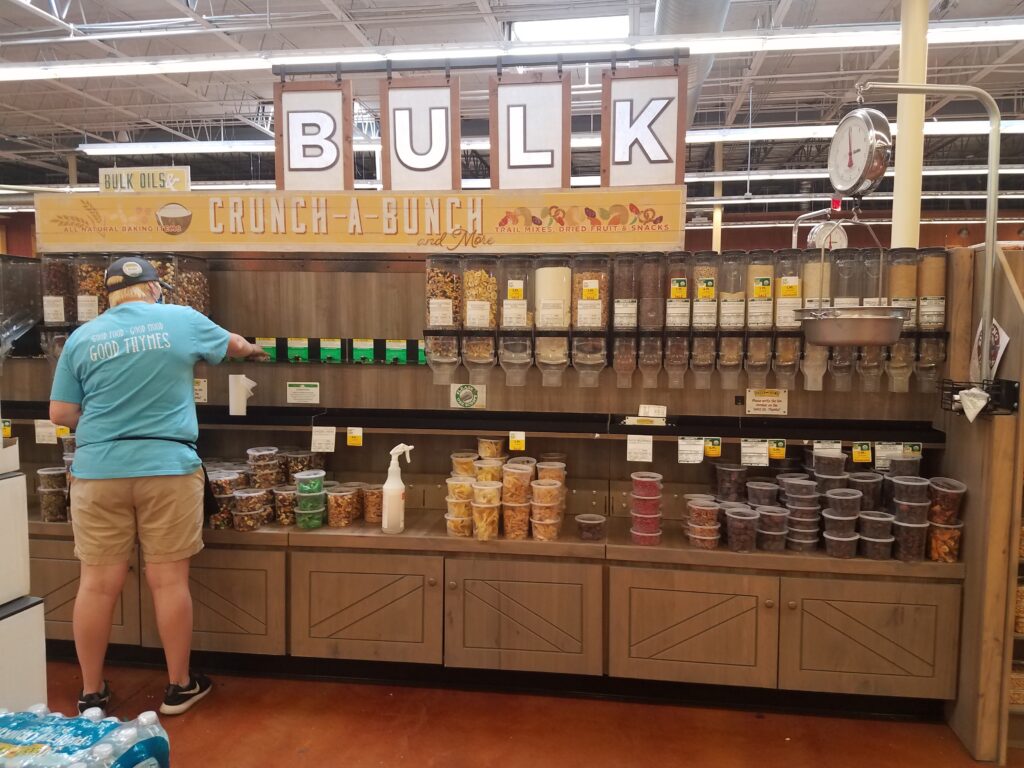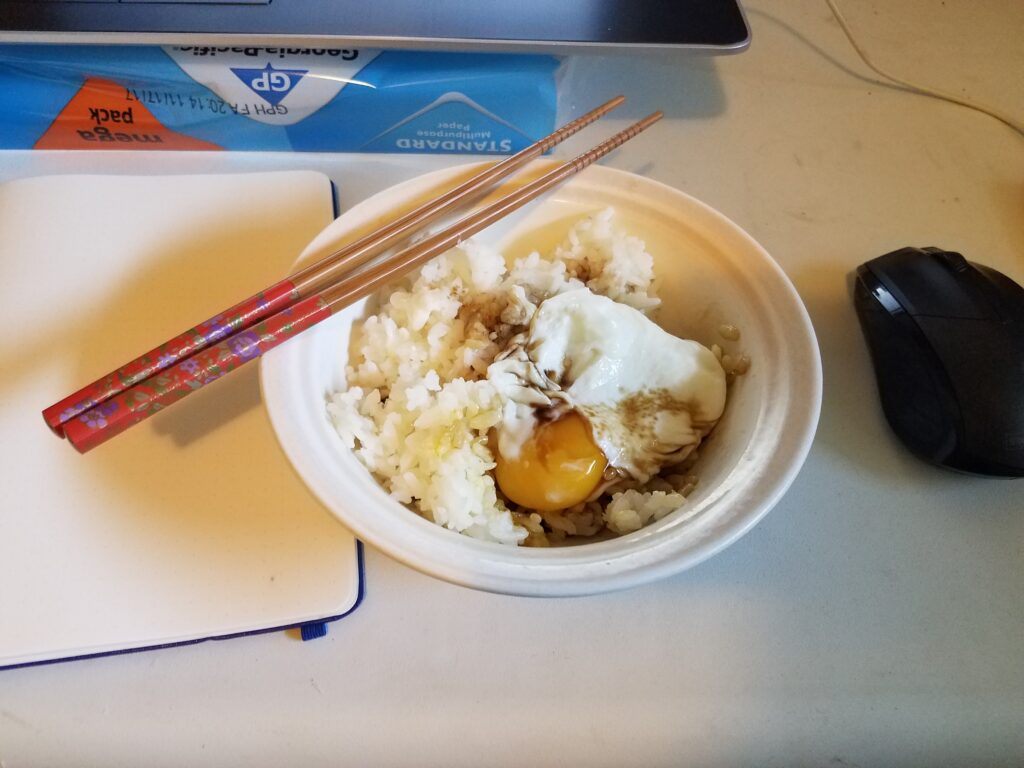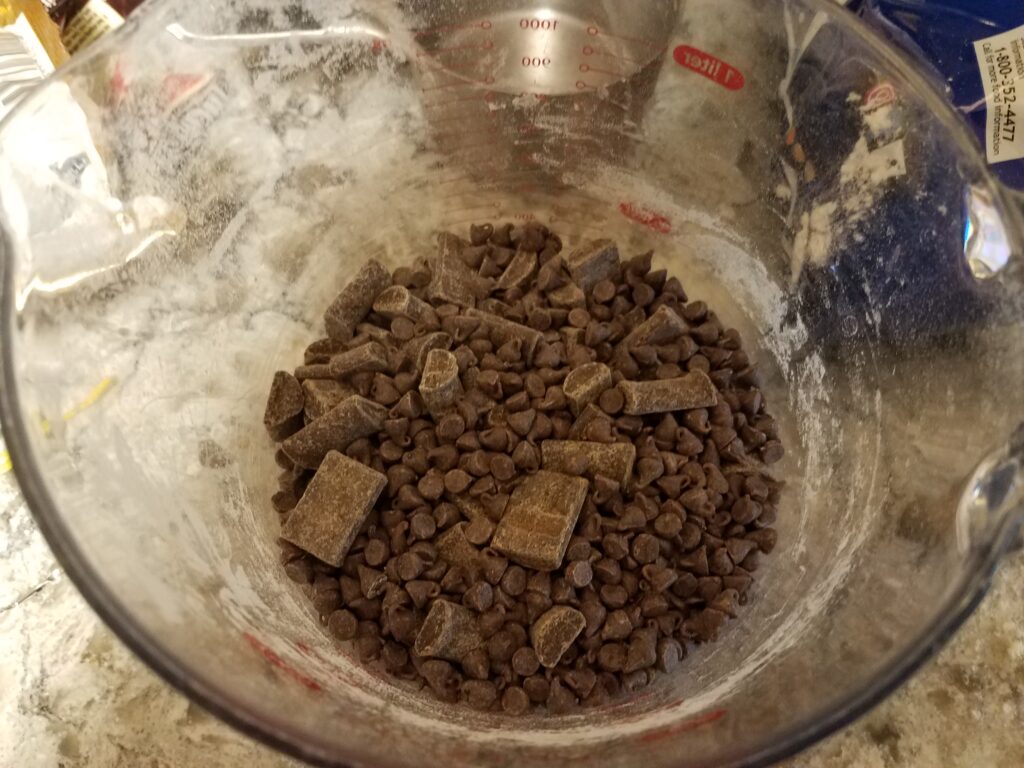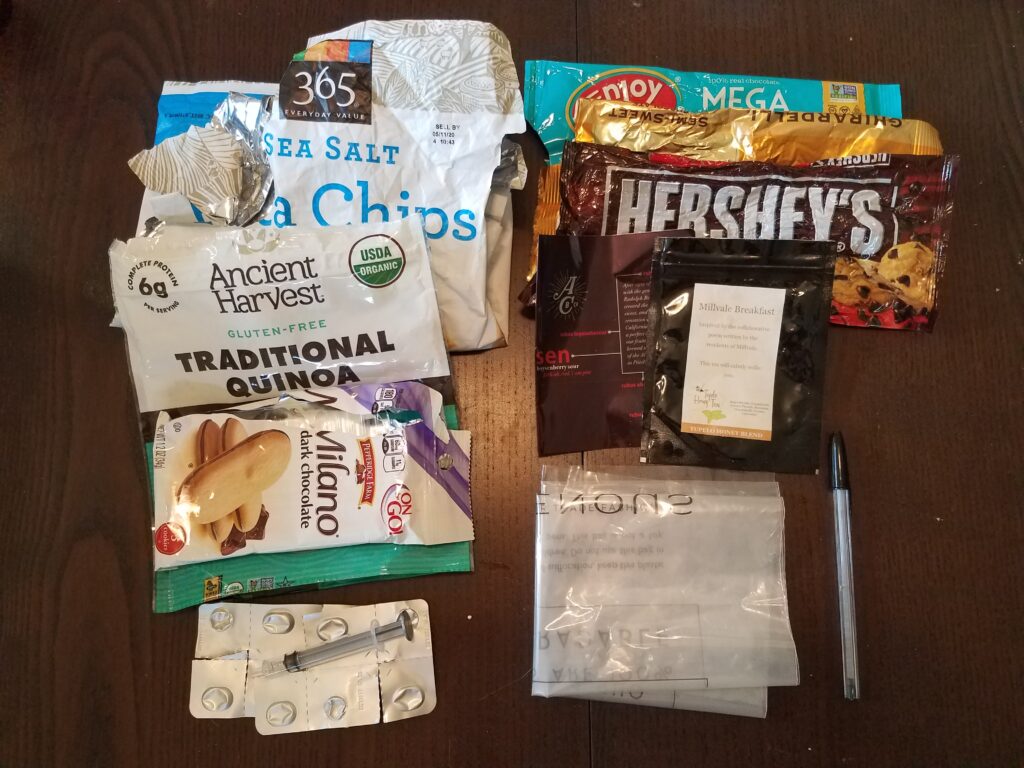Part 3 – Shopping and Cooking
In an attempt to limit my personal demand for plastics and keep those items out of the waste stream, I’ve cut back on takeout and delivery food as much as possible. Since food from restaurants is largely off the table (haha) I have been cooking more than usual, at least more than I would have been if not for Plastic-Free July. In cooking more, I’ve tried to turn first to what we’ve already got stashed in the back of the cupboards before shopping – and that has been an eye-opening experience.
To cook or not to cook?
While I absolutely love to cook, I’ve had very little time and energy for it these days. I started my new job at the beginning of March and had 9 days in the office with my team before I sent them all home to work 100% remotely. Over the last four months, I’ve spent my days learning as much as I can about the organization, our industry, and my teammates. Part of that involves frequent, intentional, and focused outreach to everyone on staff over more Zoom calls than I ever could have imagined possible. Consequently, by the end of the day, I’m pretty wiped out.

As I’ve been more focused on work, I’ve been less focused on tasks around the house, including cooking. I certainly could put in more effort in the kitchen, but I wait all year for summer weather, so when the weekend rolls around, I spend whatever time I can writing on the porch or pulling weeds in the garden. I was much better about cooking for the week every Sunday at the beginning of the pandemic when I had no desire to be outside, but even then, I was not happy about the amount of plastic packaging that came with the ingredients I bought.
Shopping in the time of Corona
Plastic consumption associated with groceries has increased since the pandemic, since I can’t bring my own shopping bags or mesh produce bags to the store. I can either use a plastic produce bag there, which I don’t want to do, or put my lettuce directly in the cart, on the belt, etc., which I also don’t want to do. For those reasons, I have been purchasing less produce, but also less cheese and less pasta, all of which involve some level of plastic packaging. I’ve been buying more canned goods – lots of beans and soups – and relying on what’s in my cabinets, which has been illuminating in its own way. (How many half-used bags of quinoa can one person have?)
With regard to shopping, I want to go on the record saying that I completely understand, respect, and comply with my local grocery store’s policies about not bringing my own reusable bags into the store and not being able to scoop my own bulk items. That doesn’t mean I don’t cringe at seeing the resulting increase of plastic containers. As a result, I’ve been avoiding most of the bulk items, such as nuts, granola, and dried beans, even if I miss them. And while I don’t bring my reusable shopping bags into the store, I can’t bear to use plastic grocery bags. I leave my reusables in the car, request no bags when checking out, and bag my groceries in the parking lot, straight from the cart.

In Japan, I would just crack an egg directly over my steamed rice in the morning, but this is close enough to spark my nostalgia.
Plastic-free Cooking (or as close as possible)
Oatmeal
Most of the food I’ve been eating on a daily basis is significantly less adventurous that I’d like, but it gets the job done. Christian bought me a 10 pound box of Quaker oats (containing two 5 pound plastic bags) at the beginning of quarantine, and I’m still not even halfway through it. I’ll make a bowl of that for myself in the morning, mixing in flax seeds, nuts, or whatever dried fruit I can find in my cupboard.
Eggs
We’ve also been going through a lot of eggs. Usually I’ll make myself an extravagant omelet with cheese and pesto (though I’m avoiding the plastic-wrapped cheese and the pesto from a plastic jar this month). Lately I’ve been making hard boiled or sunny-side up, whatever I’ve got time for in between meetings. Sometimes I get fancy and poach one to put over steamed rice with a little bit of soy sauce. It’s similar to one of my favorite breakfasts in Japan, where the egg is raw. (Salmonella isn’t a concern there.)
Breads, and cakes, and cookies, oh my!
I made a batch of chocolate chip cookies this week after finding four half-used bags of chocolate chips, mini chips, and chunks in the cupboard. (I’m afraid to admit that some of them may have made the journey from my old apartment four years ago. Fortunately the cookies tasted good.)
I’ve also been perfecting my pancake and scone recipes, though more as an experiment on how to use discarded sourdough starter. I’ll include the pancake and scone recipes in an upcoming post on that ill-fated attempt.
(Spoiler alert: the only success that came from that adventure was learning some good things to do with the discarded dough.)

Recipes: Soup and Salad
For days when I am feeling a little more energetic and don’t just want to open a can of soup or microwave some oatmeal, I’ve been trying to make a little more of an effort with tasty recipes that don’t result in a lot of plastic waste. Here are two in particular that I’ve been sharing with friends since the start of quarantine…
Zesty Quinoa Salad [1]
This protein-packed and flavor-packed salad has been my go-to for potlucks for years. I’ve been making it a lot lately 1) because it’s easy, and 2) because I have so much quinoa in my kitchen right now. The quinoa purchase will probably have some plastic associated if you can’t shop in bulk, and the tomatoes will come in plastic unless you’ve got your own plants at home. But other than that, you should be good.
Ingredients:
- 1 c quinoa
- 2 c water (or veggie broth!)
- ¼ cup olive oil
- 2 limes, juiced
- 2 tsp cumin
- 1 tsp salt
- ½ tsp red pepper flakes
- 1 ½ c halved cherry tomatoes
- 1 15oz can black beans (I also add 1 15oz can of chickpeas)
- 5 green onions, chopped
- ¼ c fresh cilantro (yuck!)
- Salt and Pepper to taste
Cook the quinoa according to instructions on package. Whisk olive oil, lime juice, cumin, salt, and red pepper flakes together. Combine quinoa, tomatoes, beans, and onions. Pour dressing over quinoa mixture and toss to coat. Stir in cilantro and season with salt and pepper.
Vegetable Broth from Scraps
Note: This recipe is in the Bad Manners (formerly Thug Kitchen)[2] cookbook, but not currently on their website. I would recommend checking them out for some amazing recipes and beautifully foul language, to which I do not do justice here.[3]
Ingredients:
- whatever vegetable scraps you have from cooking, e.g. onion and garlic skins, carrot peels, celery tops, ends of leeks, herbs that are dried out or wilted, mushroom bits, bell pepper bits, etc.
- nothing bitter like cabbage, broccoli, or cauliflower
Keep a gallon storage bag in your freezer and fill it with scraps whenever you cook. Bring 5 cups of scraps to boil with 9 cups of water, and add salt, pepper, and 1-2 bay leaves if you have them. Simmer over medium heat for one hour. Cool and strain. Refrigerate and use within a week or freeze and store for longer. Refill your scrap bag.
I have shared this one with more friends than I can count, especially since the start of quarantine because it involves saving cooking scraps and squeezing more deliciousness and use out of them. It’s so easy and so good that I will never use store-bought broth again, which also saves on that Tetra Pak (an item that is un-recyclable in Pittsburgh)![4]

Plastic from the rest of the house: packaging from two dresses I ordered in June and an inkless pen
The only new plastic purchased so far: pill packaging and a plastic syringe for kitty medication
Month to Date
My plastic stash for July is growing, but not from new purchases. A couple online orders from June have arrived in the mail, more plastic bags from ingredients have departed my kitchen, and the pen I’ve been using for work ran out of ink. The only new plastic that came into the house this week was related to prescriptions for my cat, which I could argue is not my plastic, but he’s dealing with enough right now – I’m not going to saddle him with a pile of shame.
~
Next week we’ll move from the topic of food to that of clothing, something that has been bothering me since the inception of this blog and my original Zero-Waste Lent challenge.
Thanks for reading!
[1] https://www.allrecipes.com/recipe/229156/zesty-quinoa-salad/
[2] https://www.badmanners.com/change
[3] https://www.badmanners.com/recipes
[4] https://medium.com/climate-conscious/tetra-paks-are-100-recyclable-but-are-they-sustainable-849949e763e5
0 Comments